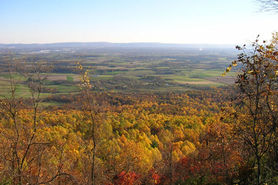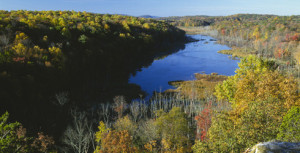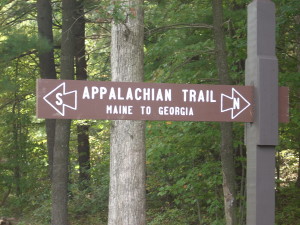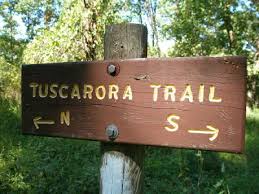On Saturday, Nov. 21st the Duncannon Outdoor Club hiked approximately two miles on a VERY rocky section of the Tuscarora Trail at Waggoner’s Gap on the Kittatinny Ridge. It was a beautiful day and the mountaintop views were spectacular! Only one raptor flew by and it was identified as a Red tailed Hawk. (A raptor being a bird with a hooked beak and having talons.). After spending a little time looking for other raptors the group headed out on the trail.
The Kittatinny Ridge is a 200 mile uninterrupted forest that begins in the northern end of New Jersey, continues through Pennsylvania, and ends at the Maryland state line. It provides habitat for many species, especially those that cannot survive in fragmented forests.
Rain and snow falling on the forested ridge provides a water source for creeks, seasonal water sources, vernal ponds, and wet lands. It also is a major source of drinking water for the thousands of people living below the ridge.
The ridge is also an important hiking area. One-hundred-sixty miles of the famous Appalachian Trail run along the ridge. The Tuscarora Trail joins the Appalachian Trail and continues another sixty miles along the ridge into Maryland. There are also the many less well known trails that exist on the ridge.
The Kittatinny Ridge is recognized as a “globally significant” migration flyway for thousands of raptors and millions of songbirds in the spring and fall. (A flyway is a flight path used in bird migration.) There are four major flyways in North America: the Atlantic Flyway, the Mississippi Flyway, the Central Flyway, and the Pacific Flyway.
The Autubon of Pennsylvania has also officially designated the ridge as the states largest “Important Bird Area”.
The Kittatinny Ridge is part of the Atlantic Flyway and is under the auspices of The Blue Mountain Kittatinny Ridge Conservation Project. This project is a collaborate effort of local, regional, and state organizations and agencies focusing public attention on the importance of the Kittatinny Ridge. Goals of the project include: Development of a long-term conservation vision, and to provide tools and resources to help citizens, local government, landowners, and civic groups implement the vision at the local level. These goals are already being challenged as can be seen by the recent houses appearing on the mountaintops.
If you are interested in preserving the Kittatinny Ridge and the Atlantic Flyway it provides visit http://nature.org/adopt to find out how you can adopt an acre. You have the opportunity to protect and restore the Central Appalachians.
Discussion of the five water gaps was included with the discussion of the Blue Mountain-Kittatinny Ridge, because the ridge creates the Blue Mountain Water Gap, the fifth and the southernmost of the gaps.
What exactly is a water gap? It is a short gorge or valley cut by a river through a resistant ridge or mountain range. The five water gaps along the Susquehanna River just North of Harrisburg have been recognized as a National Natural Landmark. The dedication marker for the Susquehanna Water Gaps can be located along 11/15 in Marysville, PA at the Senic Overlook.
The first water gap and most northerly is The Mahantango (Buffalo Mountain west of the river. Going south, the 2nd gap is Berry Mountain. The 3rd is Peters Mountain, with Second Mountain (Cove Mountain west of the river) forming the 4th water gap. As mentioned previously, the Blue Mountain – Kittatinny Ridge forms the 5th water gap.
It is hard to imagine that people over the world come to our area to witness a geological national natural landmark and appreciate our mountains and flyways. We are very fortunate to live around such wonders.







![north-america-migration-flyways[1]](https://duncannonatc.org/wp-content/uploads/2015/12/north-america-migration-flyways1-300x300.jpg)
![susqquehanna-water-gap[1]](https://duncannonatc.org/wp-content/uploads/2015/12/susqquehanna-water-gap1-300x200.jpg)